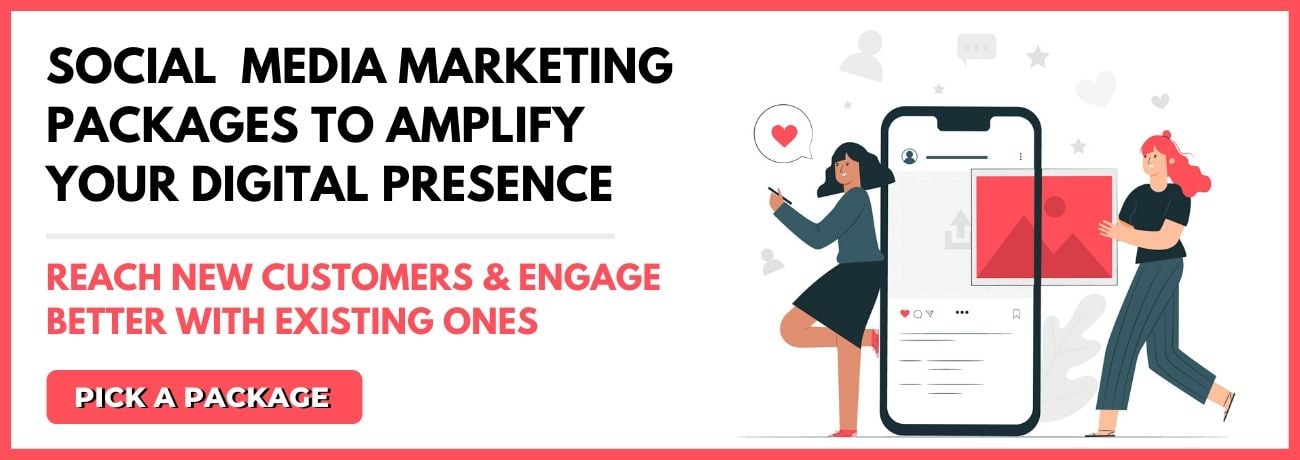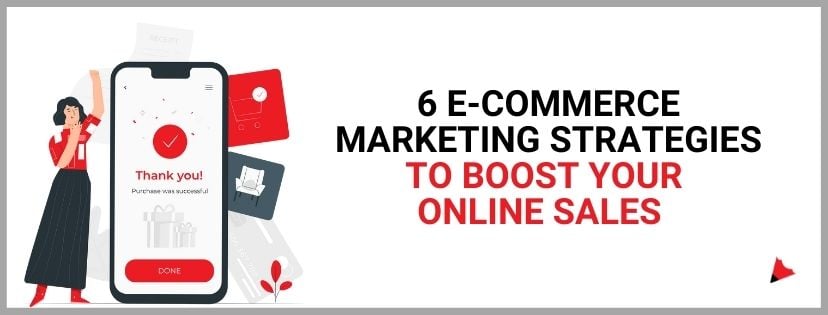
Looking for eCommerce marketing strategies to flood your online store with traffic and sales?
In this article, you’ll find 6 strategies to crush your eCommerce sales goals and build a multi-million dollar eCommerce brand.
For starters, let’s quickly brush up on the definition -
What is eCommerce Marketing?
Ecommerce marketing is the process of using marketing strategies & tactics to drive awareness and acquire customers for an online store.
Although most of these tactics are executed on digital platforms, they can also include offline strategies like print ads, billboards, speaking at events etc.
Now that you’ve gained clarity on the basics, let’s dive into the 8 eCommerce marketing strategies for your online store:
1) Social Media Marketing
According to statista, social media ad spends are projected to reach $110,628m in 2021.
Moreover, by the end of 2021, social media could account for a third of the total digital media advertising spend in the MENA region (Source)
The reason we’ve placed social media marketing at the top of our ecommerce marketing strategy recommendations is because of its insane targeting capabilities and cost-effectiveness.
For example, on Facebook, you can narrow your ad targeting by demographics, interests, pages that people have liked, and much more.
After all, better targeting = cheaper clicks.
Social media ads are also incredibly helpful if you’re selling products in a niche market - thanks to impressive targeting parameters and remarketing capabilities.
Here are some examples of social media eCommerce ads for our client, Sennheiser.
Find out how we helped Sennheiser achieve 2000% ROI. Read the whole case study
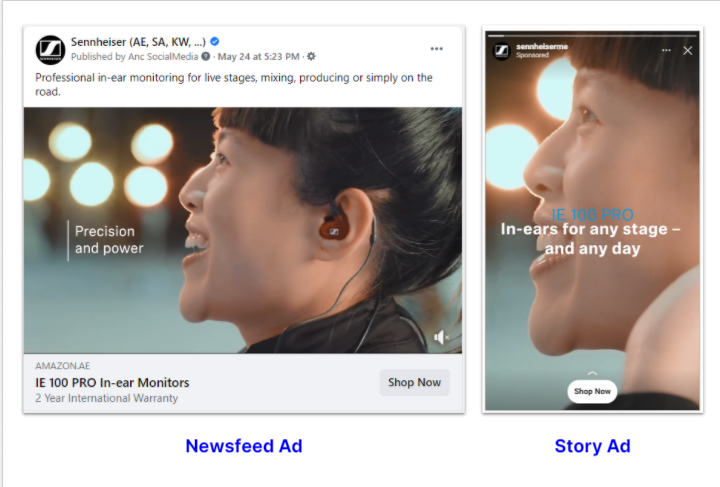

If you’re a new eCommerce store, you might be skeptical about spending too much advertising budget in the beginning (and that’s understandable)
The key to succeeding at digital advertising for ecommerce is to monitor your ROAS (Return On Ad Spend).
Calculating ROAS
For example, a company spends $2,000 on an online advertising campaign in a single month. In this month, the campaign results in revenue of $10,000.
Therefore, the ROAS is a ratio of 5 to 1 (or 500 percent) as $10,000 divided by $2,000 = $5.
For every dollar that the company spends on its advertising campaign, it generates $5 worth of revenue.
A positive ROAS means your ads are directly contributing to sales.
Ecommerce stores like MVMT (pronounced “movement”) have grown to revenues of $100 million, with Facebook ads driving a big part of their sales.
The secret to winning at social media ads is to constantly experiment with advertising variables.
Since we can never predict the outcome of any particular ad, it’s crucial to have a kaizen approach to ecommerce marketing (Japanese for continuous improvement)
You can test the following variables to notice differences in results generated by each variable:
- Videos vs. images;
- Ad placements (feed or stories);
- Ad Copy
- Location
- Audiences
2) Google Ads
While social media ads operate on "push-messaging" wherein you "interrupt" people with ads, Google ads have a slightly different style.
With Google ads, you can show ads to people when they're searching for your products (or your competitors) using keywords and other targeting parameters.
That's in contrast to Facebook & Instagram, where you can't target ads using keywords but rather interests, demographics, and behaviors.
Google ads are crucial even though you're doing SEO, simply because SEO is a long game while Google ads can give faster results.
For eCommerce marketing, there are three types of ads you can test.
- Google Search ads;
- Google Display retargeting; and
- Google Shopping ads;
P.S - Google also offers a fourth type of ad format which is video that runs primarily as YouTube ads and on other Google partner sites). We’ll cover more about video ads in another article.
For now, let’s focus on the top 3 ad formats.
1) Search adsIn simple words, these are ads that display in the search results for any particular keyword/s.
The fundamental key to winning Google search ads for eCommerce marketing is - Targeting the best keywords for your brand.
Although there are various strategies for running successful Google search ads, following are some evergreen tips to get started: Of course, there are plenty of strategies for doing this online, but here’s one that can help you get started right away:
- Target keywords that your competitors are bidding on;
- Target category/product keywords to get your product found among relevant searches;
- Target keywords highlighting the pain points that your product solves.
For example - if you sell neck massagers, you might want to target keywords like "neck pain relief" too.
Following is an example of a Search ad.
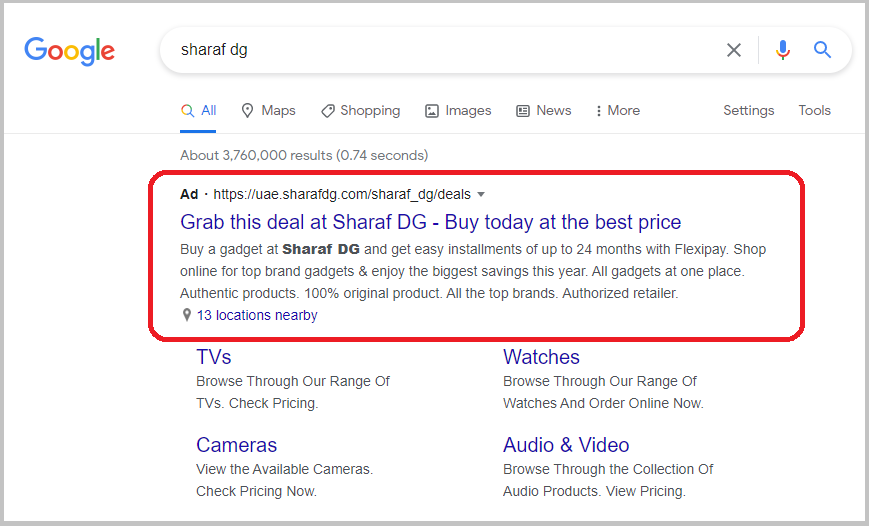
2) Display Retargeting
Retargeting (as the word suggests) is an online advertising strategy that allows you to target audiences who have visited your website or interacted with your ads (Google, social etc.)
It's a very powerful strategy for reminding users to consider your product and complete the purchase.
Here’s how retargeting works:
- You install tracking codes on your website (simple copy-paste);
- These codes help Google understand user behavior on your website
- If somebody visits your website and then visits other websites that show Google ads (Adsense), Google will “retarget” them with your ads.
To be successful at retargeting, it's important to understand your buyer's journey and marketing funnel.
Based on those insights, you can craft ads that push them into the next stage of your marketing funnel, eventually leading to a purchase.
For example - if someone visited one of your ecommerce product pages and even added an item to cart but dropped off and didn't check out, you could retarget them with ads that encourage them to complete the purchase.
Your potential customers may abandon their cart for multiple reasons.
That's why retargeting ads work because they target that very reason to persuade them to purchase.
Following is an example of a Display Retargeting ad we can for our client, Sennheiser.

3) Google Shopping Ads
This is a Google Shopping ad:
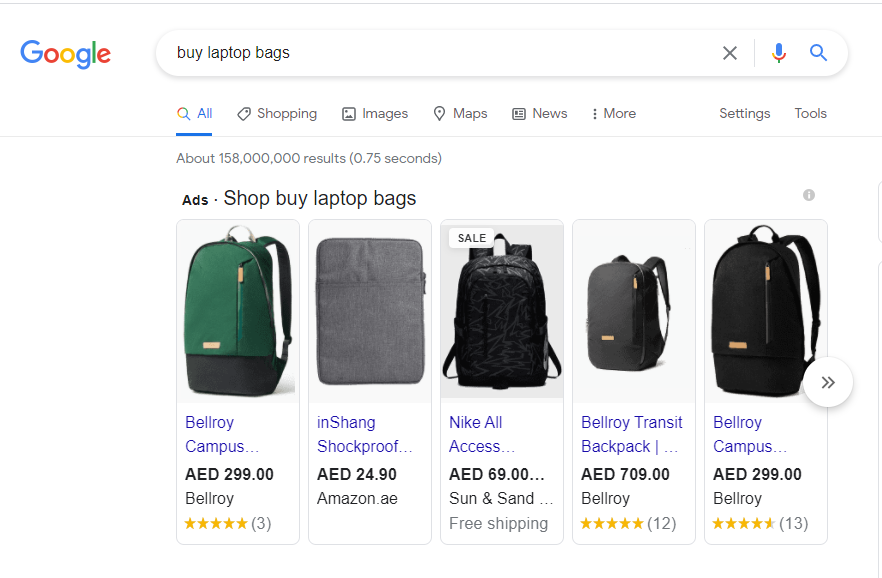
Also known as Product Listing Ads (PLAs), Google Shopping ads are sacrosanct for growing your ecommerce store since they appear on top of search ads and organic results.
Google shopping ads have better conversion rates since they're powered with product images as well as ratings, while enjoying premium real estate on the search results page.
Here's Google's official guide to get started with Shopping Ads.
3) Email Marketing
“Email marketing is the king of the marketing kingdom with a 3800% ROI and $38 for every $1 spent.”
The statement above was released by Campaign Monitor who swear by email marketing campaigns as their bread & butter.
If that statistic wasn’t convincing enough, I’ll throw another one at you by McKinsey –
Here’s what their research suggests:
“Email marketing is 40 times more effective at acquiring new customers than Twitter and Facebook combined.”
Many brands underestimate the power of email marketing, but the truth has been laid bare above.
Following are the fundamental steps required to build an email list for ecommerce marketing:
Step 1 - Generate traffic to your website.
Step 2 - Convince website visitors to sign up (using discounts and other perks)
Step 3 - Nurture them and stay on top of their mind with content that matters to them, whether it's educational, entertaining or simply informs about the latest offers)
Many ecommerce websites (like the one below) build their email list by giving sign-up discounts.
This tactic works wonders because it serves 2 purposes:
- Growing the email list; and
- Enabling first-time customers to try out the brand

Once you have people signing up to your list, create an onboarding sequence to keep them engaged.
That might be a welcome email series introducing yourself, your company, and pointing them to a few informational resources you have.
Or you could direct them to your product catalog.
And don’t forget: you can also send abandoned cart emails.
These are emails you send after shoppers add products to their carts, but exit before making payment.

About 70% of shoppers abandon their carts, and these emails can help to nudge them towards making a purchase.
Learn how to write abandoned cart emails that work in this guide.
Remember: in the end, the purpose of email marketing is to build a good relationship with your customers.
When your customers are engaged, you can maintain top-of-mind awareness and encourage them to visit your store again and again—generating more sales for you.
So, don’t just send a couple of onboarding emails and leave it at that.
Figure out ways to continually add value and engage with them.
This could mean sending them your latest blog post, telling them about new products, offering discounts, celebrating with them, etc.
4) Content Marketing
Content marketing is the process of creating online content to teach potential customers how to solve the problems they’re facing, and how your product can help with that.
For example, Beardbrand teaches bearded gentlemen how to shape their beard, and promotes their products in the process.
Here are two ways to get started with content marketing.
A. Target topics with search traffic potential
One of the biggest mistakes that businesses make when blogging is writing me-focused content.
Unless you’re a celebrity with a large following, that strategy won’t work.
Sure, you might get a small spike of traffic as you promote it to your existing audience.
But soon after, your traffic will disappear.
If you want your blog to grow, you need to write about topics that people are searching for.
For as long as you rank highly in Google, you’ll be able to generate passive, organic traffic to your site.
How do you find such topics?
Paste a few ideas into a free keyword tool like Google Keyword Planner. Or, to get a broader set of keyword ideas, use a tool like Ahrefs’ Keywords Explorer.
B. Rank videos on YouTube
At 3.2 million subscribers, Luxy Hair is killing it on YouTube.
Not only have they built a community of hair fanatics, but they’re also ranking for plenty of relevant keywords.
Whenever someone looks for hair-related videos, Luxy Hair is there. And this allows them to drive awareness of their products and demonstrate them in action. They can also point subscribers towards their online store to buy products.
On YouTube, everyone has an opportunity to rank.
Since YouTube wants viewers to stay on the platform so they can make more ad dollars, they’ll reward anyone with visibility if they can make entertaining and engaging videos.
Want to learn more about YouTube SEO? Check out this detailed guide by HubSpot
5) Search Engine Optimization
43% of ecommerce traffic comes from organic Google searches.
Translation: if you’re not showing up on Google for your target keywords, you’re missing out on a lot of traffic—and possibly sales.
Enter SEO.
SEO is the process of optimizing the pages on your ecommerce store to rank in Google and other search engines.
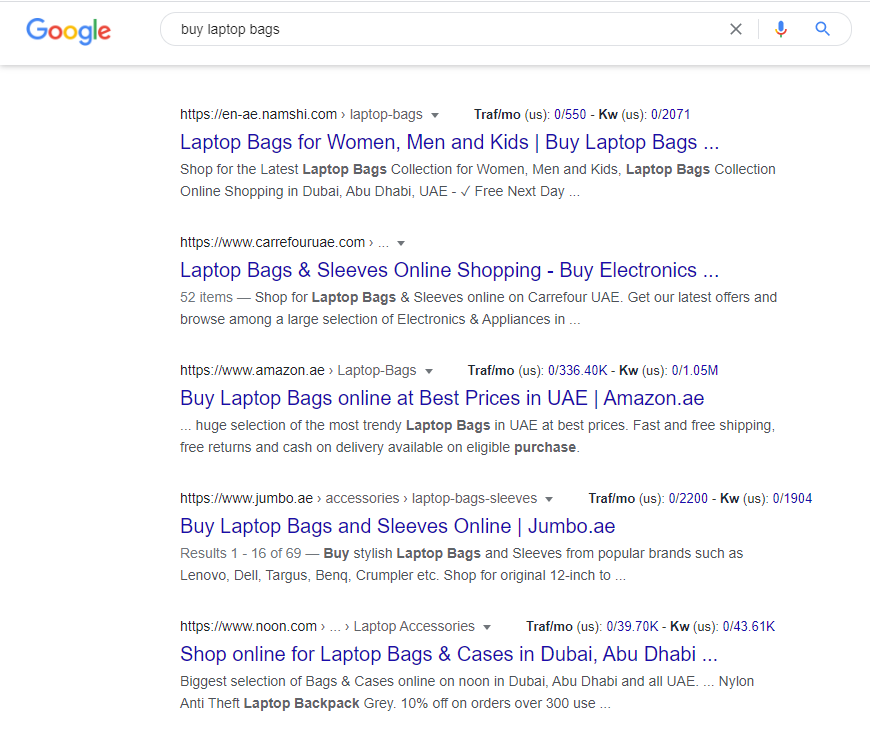
As you can see above, most local ecommerce local brands have SEO'd their pages to rank high for products.
Here's a simplified process to get started with eCommerce SEO:
Do keyword research. Brainstorm a few words or phrases that one might type in Google to find your product. Note down any relevant and popular keywords.
Identify search intent. Make sure that people searching for this keyword are in buying mode. To do that, search Google for the keyword and check that it’s mostly product or category pages ranking in the top 10, not blog posts.
On-page optimization. Create an appropriate page that matches search intent, and optimize your title tag, description, H1, URL, and product descriptions for your target keyword.
Build links. Link building for product or category pages is notoriously tricky. But you can use tactics like the Middleman Method to make this easier.
Check out HubSpot's extensive guide on eCommerce SEO.
6) Marketplaces like Amazon, noon etc.
What’s the end goal of marketing your online store? More sales, right?
If so, there is no better place than the world’s biggest marketplace: Amazon.
While you’d likely not be able to drive traffic to your store this way, in exchange, you’ll gain access to millions of shoppers who prefer to buy from Amazon.
Matter of fact is - If you’re not selling your products on Amazon, someone else will.
In that case, you should get in the game and control what your customers will see.
Now, this isn’t a blanket recommendation.
Whether you should sell on Amazon depends on whether you have a product with existing demand.
If you have something that people already want or buy (e.g., baby products, speakers, mattresses), then Amazon is fantastic.
If you’re selling something with unknown demand, then it might not make sense.
Getting your products on Amazon could be an entire article on its own, so check out this comprehensive guide.
Of course, getting your product on Amazon doesn’t mean you’ll automatically start generating more sales.
The ease of selling there means that thousands, if not, millions of other small businesses are fighting for the same attention as you are.
They, too, want a piece of the pie.
To stand out, you’ll have to rank well.
Amazon has a unique ranking algorithm called the A9 algorithm.
To rank, you’ll have to optimize your product title, bullets, descriptions, and backend search terms.
The keywords you choose to include in these areas will be the key that helps you rank on the first page of search results.
Check out this product listing example by our client, Sennheiser.
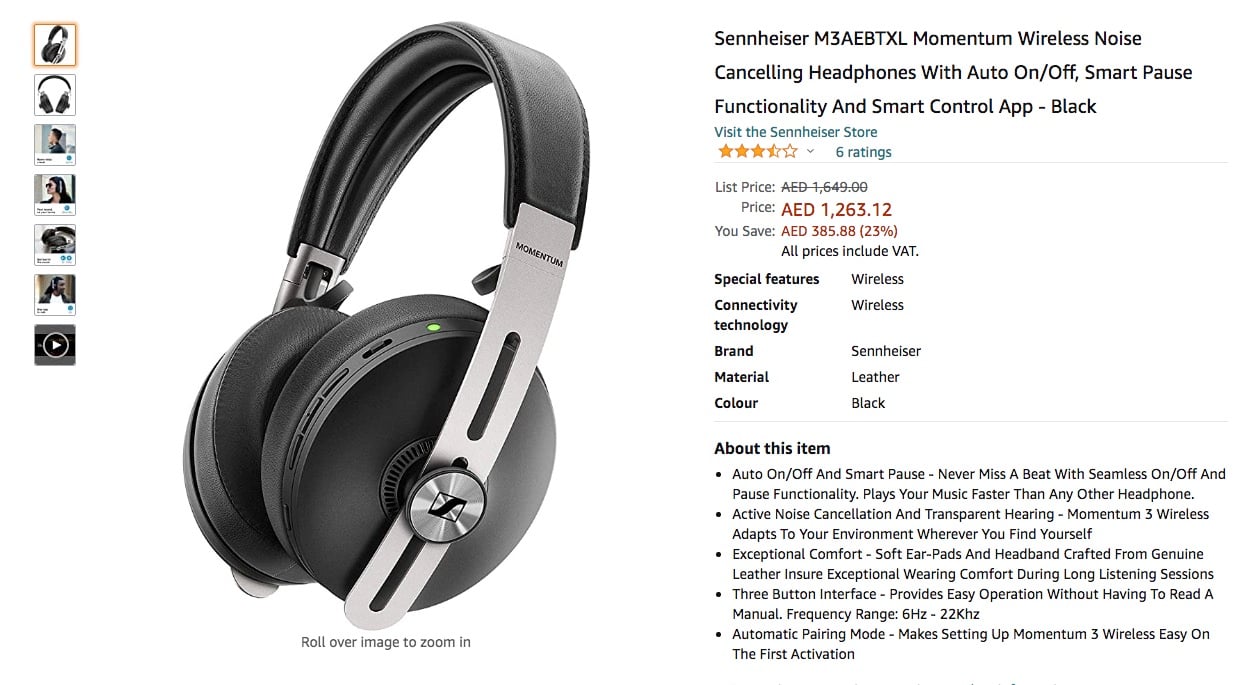
You'll notice how all the elements of the product are fully optimized to ensure visibility and guide purchase decision.
Aim to do the same with your brand by being as descriptive and helpful as possible.





